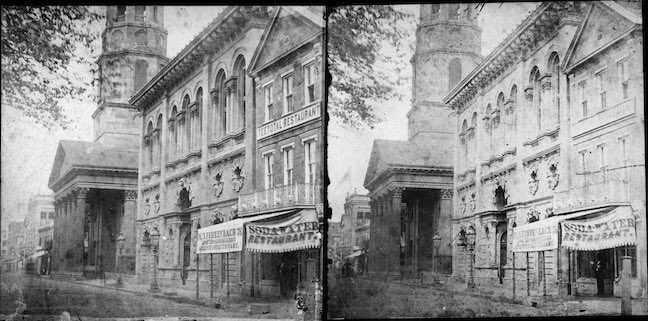| Credit: | by Osborn & Durbec |
|---|---|
| Date: | 1860 |
| Negative Size: | stereo |
| Locations & Lines: | Charleston SC; South Carolina |
| Structures & Establishments: | Circular Congregational Church (Charleston SC); Secession Hall (Charleston SC); Teetotal Restaurant (Charleston SC) |
| Sources: | Library of Congress |
$5.99
File Details: ARYEm, 800 DPI, TIFF, Original Photograph, 12.3 Mb
Image ID: ARYE
No. 5. South Carolina Institute Hall–Charleston, S. C. This spacious and elegant Hall was situated on the East side of Meeting street, between Quen and Cumberland streets. It was begun in March, 1853, and finished in December, 1854. This Hall obtained great celebrity, especially in a national point of view. Being the most commodious Hall in the City, accommodating some twenty-five hundred persons on the main floor and gallery, it was selected as the place of meeting of the Democratic National Convention, which assembled in Charleston on Tuesday, the 24th of April, 1860. The Hon. Caleb Cushing, of Massachusetts, presided over the deliberations of the Convention. This Convention, after a stormy session of ten days, and without effecting a nomination, adjourned on the 3d of May, to meet in Baltimore on the 18th of the succeeding month. At the adjourned session of the Convention, Ex-Governor Todd, of Ohio, was chosen to preside, in place of the Hon. Caleb Cushing. The Convention, after several days session, nominated the Hon. Stephen A. Douglas for the Presidency, and the Hon. Benjamin Fitzpatrick of Alabama, for the Vice-Presidency. The Institute Hall, in later years, was known as “Secession Hall,” from the fact that the Ordinance of Secession was ratified within its walls, on the 20th December, 1860. The Convention which declared the State of South Caroliina no longer a part of the Confederating known as the United States, first assembled in the Baptist Church in Columbia, on the 17th December, 1860. At the Evening Session on that day, in consequence of the prevalence of smallpox in Columbia, the Convention adjourned to meet in Charleston. The Convention, at 4 P.M. the following day, met at St. Anthony’s Hall on Broad street, where the deliberations of the body, the most important ever assembled in this country, were continued to be holden until the adoption of the “Ordinance of Secession,” on the 20th December, 1860, when it was resolved to adjourn to Institute Hall for the purpose of ratifying the Ordinance. At 6 P. M., on the 20th December, 1860, the Convention moved in procession from St. Andrew’s Hall to Insitute Hall, where, after prayer by the Rev. John Bachman, D. D., the Ordinance was most solemnly ratified, receiving the signature of every member of the Convention. At the conclusion of the signing of the Ordinance, the President of the Convention, the Hon. D. F. Jameson, of Orangeburg District, exhibited the parchment to the meeting, announcing that “the Ordinance of secession had been signed and ratified. He, therefore, proclaimed the State of South Carolina an Independent Commonwealth!” On this announcement the whole audience rose and gave vent to their enthusiasm in prolonged cheers, accompanied with the waving of hats and handkerchiefs. The occasion was celebrated in the evening by a general illumination and bonfires in the principal streets, and the parading of citizens with bands of music. Both the South Carolina Institute (or Secession) Hall, and St. Anthony’s Hall, fell prey to the terrible conflagration which laid waste about one-third of the fairest portion of Charleston on the night of the 11th December, 1861. The imposing edifice to the left of Institute, or Secession Hall, is the Circular Church, which was erected in 1804, on a circular plan of 88 feet in diameter, at a cost of about $75,000. The site of this Church was at one time occupied by a wooden building, known as the”White Meeting,” which was built in 1690, and served as a place of worship for nearly one hundred and fourteen years. It was pulled down to give place to the magnificent Church edifice which was destroyed during the conflagration of December 11, 1861. The Charleston Hotel can also be seen in he distance, on the left. [Quinby & Co. stereo card]
South Carolina Views. No. 18. Institute Hall–Known as Secession Hall. The Act of Secession was ratified in this well known Building. The Circular Church is seen on the left. Both buildings were destroyed by the fire of 1861. [G. N. Barnard stereo card]

